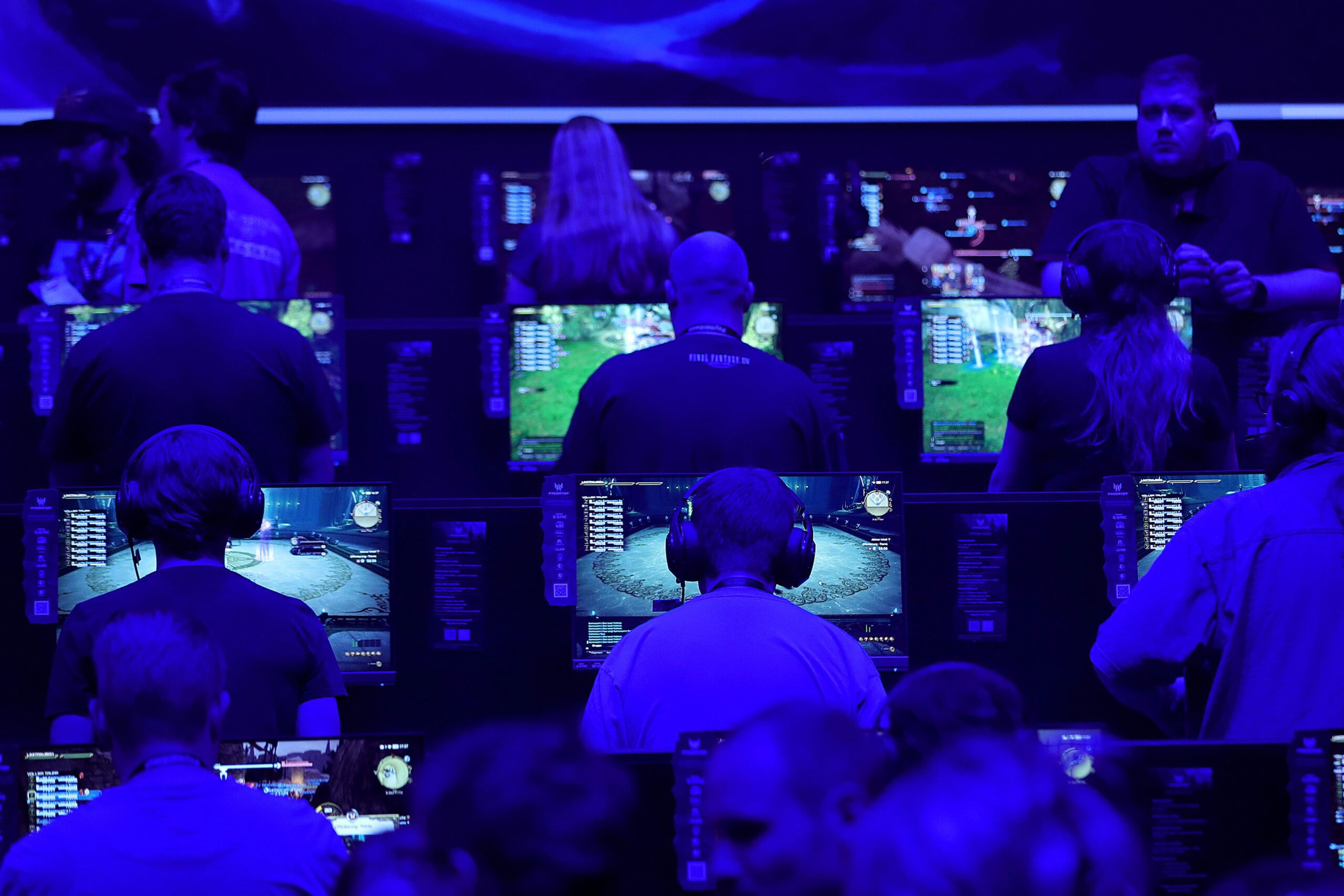(Bloomberg) —
Few people think regularly about the carbon footprint of their smartphone. Understandably: One iPhone 14, for example, generates roughly 61 kg of carbon in its lifetime — the equivalent of a single drive from Washington DC to Philadelphia. But apply that to the 237 million iPhones Apple shipped in 2021, and those emissions climb to 15 million metric tons, five times more than Washington DC’s annual emissions from fossil fuels. Like so many aspects of our daily lives, from cheeseburgers to cars to new clothes, scale is the difference between negligible climate cost and noticeable climate footprint.
Video games, too, have a little-discussed but growing problem with scale. While the amount of electricity used by a single gamer is small, roughly 40% of the global population — more than 3 billion people — now play video games of some sort, many for multiple hours a day. The proliferation of gaming hardware, which relies on increasingly scarce materials and complex supply chains, as well as the energy required to power a pastime growing in popularity, are starting to draw the attention of climate experts. With the world on track to add 600 million more gamers by 2027, addressing those challenges now could be an important step in a quest by the industry to make itself greener.
“The emissions per hour of gaming aren’t so much, but collectively they are,” says Mike Hazas, a professor specializing in sustainability and digital technology at Uppsala University in Sweden.
Some 60 years after the debut of the world’s first video game — rudimentary tennis played on an oscilloscope screen — gaming has grown into a global business worth $214 billion. With that growth comes an increased environmental impact. Video games’ climate footprint starts with the tens of millions of consoles, cartridges and discs manufactured each year and shipped around the world. Many consoles, like other electronic devices, make ample use of plastic, silicon and mined materials such as coltan and nickel.
Sony’s PlayStation 4, for example, is one of the world’s most popular gaming consoles, and has sold more than 117 million units since its debut in 2013. According to 2019 research from the University of Cambridge, making one PS4 and shipping it from China to the UK emits 89 kilograms of carbon dioxide, a tally that includes everything from mining metals to manufacturing and maritime transportation. That’s similar to the emissions from producing one barrel of crude oil in the US.
Once a console reaches its destination, gaming itself can be energy-intensive, though quantifying the associated emissions is tricky: They vary widely by console, game and system setup. In one of few attempts to assess the climate cost of video gaming, a 2019 peer-reviewed study estimated that American gamers collectively use up to 34 terawatt-hours of electricity annually. That’s more than the country’s largest nuclear power plant, the Palo Verde station, produces in one year.
The same study found that the energy use of all US gaming causes 24 megatons of carbon dioxide emissions a year, the equivalent of adding more than 5 million cars to the road. On the end-of-life side, out of 53 million tons of electronic waste dumped globally in 2019, nearly 10% was made up of small devices, including game consoles.
To be sure, the climate impact of video gaming is low when compared to high emitters like power generation, aviation and driving; gaming is arguably a “greener” use of time than a road trip or a far-flung vacation. But being a smaller emitter “doesn’t excuse the industry from doing everything it can to clean up its act,” says Benjamin Abraham, a gaming decarbonization advocate at Sydney-based consultancy AfterClimate and author of Digital Games After Climate Change. Abraham says conversations surrounding gaming emissions are largely missing: “It’s flown under the radar.”
As a fan of mobile game Honor of Kings, Nadia Li spends hours almost every day adventuring in her digital fantasy world. She knows the tricks to slaughter a monster. She knows her fellow players on the other side of the world. But there is one thing Li doesn’t know: how much electricity it takes to play.
“I’ve never paid attention to it,” says Li, 22, a college student in Toronto whose electric bill comes to about C$30 ($22) a month. “After all, it can’t be too much.”
Li is far from alone: Gamers aren’t generally too focused on the energy use or carbon footprint of their hobby. Some of that has to do with transparency: Unlike refrigerators and clothes dryers, it’s uncommon for gaming consoles to carry an EnergyStar rating or other marker of efficiency. And while various emissions calculators exist to help consumers estimate the climate cost of road trips, air travel and dietary choices, parsing gameplay energy from overall household power use remains a challenge.
Reed Noland, 35, who works in sales and lives in Clermont, Florida, says he plays video games two hours a day on average, but he doesn’t know how much electricity it uses or think about energy consumption when shopping for hardware. Noland says gamers might be inclined to buy energy-efficient equipment if there was solid proof of its climate impact, but for now, “most gamers don’t associate the power output of their machines with environmental issues.”
A small group of gaming enthusiasts are starting to think differently, though. On Reddit, several dozen threads exist for trading tips on energy-efficient gameplay, and YouTube videos on building a less power-hungry gaming computer are proliferating. Some boast millions of views.
One such conscientious gamer is Matthew Kiehl, a 39-year-old computer technician in Ballston Spa, New York. Driven by concerns over climate change, Kiehl says he now games on a computer assembled with the older generation of components — replacing them only if necessary in order to save resources used for making the components. Playing video games on an older computer has its trade-off, though: On some occasions, Kiehl says it could take three times longer than normal for a game to load.
Few are willing to make that kind of compromise. “If someone buys a console or gaming computer, they’re up for gaming,” says Li. “Why should we think of energy efficiency?”
As with many devices, regulatory frameworks to keep gaming’s energy consumption in check are practically nonexistent. So far, the European Union and six US states (California, Colorado, Hawaii, Oregon, Vermont and Washington) require console-makers to at least limit power draw when their devices are idle. Without any restrictions, a PlayStation 4 Pro, for instance, can consume as much as 8.2 watts of electricity an hour even if it’s not in use.
But gaming companies are starting to pick at the problem. Microsoft announced in March that it had made “Energy Saver” mode the default option on all new Xbox consoles, nixing a default standby setting that used about 20 times more energy. For those with older models, Microsoft is also exploring ways to help improve energy efficiency through software updates, says Trista Patterson, an Xbox executive responsible for gaming sustainability.
Japanese conglomerate Nintendo, for its part, says the power demand of its current Switch console is half that of the model released in 2017. Sony Interactive Entertainment said in November that its latest PlayStation 5 uses 17% less energy than the PS4.
“They’ve clearly put a ton of engineering time into improving overall system energy efficiency,” says Abraham of AfterClimate. “But have they done everything that they could?”
Earlier this year, Abraham urged console-makers to cap the amount of electricity their devices would use during actual gameplay, to no avail. (The three companies, however, have pledged to go beyond the EU’s mandatory requirements for capping energy use in standby mode, including in the UK.) Sony and Nintendo declined to comment on Ahraham’s criticism. Microsoft didn’t directly respond but said in a written statement that “sustainability is a priority.”
The next-generation trends in gaming are likely to exacerbate the challenge: As video game companies up the ante on enhanced graphics and interactive gameplay, more immersive games will require more computing power — and ultimately lead to higher energy demand. The migration of some gaming to the cloud, which eliminates expensive gaming rigs and lets gamers play via remote servers in data centers, may also prove problematic. Some experts say data centers offer economies of scale that improve energy efficiency, while others argue that the energy used to build and run such centers is at odds with climate goals.
Then there’s the rise of gaming consoles as a kind of “everything device,” one that can also play music, browse online and stream entertainment. Noland, for example, often streams movies and shows on his Xbox, a practice he thinks of as energy efficient but experts say is wasteful. A 2021 analysis from the Natural Resources Defense Council found that the Xbox uses 10 to 25 times more power to watch a show than accessing the same content via an Apple TV or Roku box.
–With assistance from Yuki Furukawa.
To contact the author of this story:
Coco Liu in New York at yliu1640@bloomberg.net
© 2023 Bloomberg L.P.





